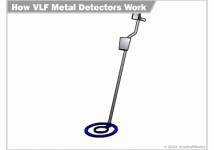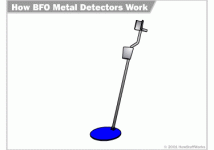Air Test Guitars... Not Detectors!
Air tests can be inconclusive, here is a method that will provide more accurate results.
Dig a hole about a foot deep, stick a coin in the undisturbed dirt in the side of the hole, push it in as far as possible. Backfill the hole and tamp the dirt, now you have a target in undisturbed soil.
Here is a diagram I made for an example.
 How Metal Detectors Work - HowStuffWorks
Metal detectors use one of three technologies:
How Metal Detectors Work - HowStuffWorks
Metal detectors use one of three technologies:
Very low frequency (VLF)
Pulse induction (PI)
Beat-frequency oscillation (BFO)
In the following sections, we will look at each of these technologies in detail to see how they work
 VLF technology
VLF technology
The receiver coil is completely shielded from the magnetic field generated by the transmitter coil. However, it is not shielded from magnetic fields coming from objects in the ground. Therefore, when the receiver coil passes over an object giving off a magnetic field, a small electric current travels through the coil. This current oscillates at the same frequency as the object's magnetic field. The coil amplifies the frequency and sends it to the control box of the metal detector, where sensors analyze the signal.
The metal detector can determine approximately how deep the object is buried based on the strength of the magnetic field it generates. The closer to the surface an object is, the stronger the magnetic field picked up by the receiver coil and the stronger the electric current generated. The farther below the surface, the weaker the field. Beyond a certain depth, the object's field is so weak at the surface that it is undetectable by the receiver coil.
 PI Technology
PI Technology
The sampling circuit sends the tiny, weak signals that it monitors to a device call an
integrator. The integrator reads the signals from the sampling circuit, amplifying and converting them to direct current (DC). The direct current's voltage is connected to an audio circuit, where it is changed into a tone that the metal detector uses to indicate that a target object has been found.
PI-based detectors are not very good at discrimination because the reflected pulse length of various metals are not easily separated. However, they are useful in many situations in which VLF-based metal detectors would have difficulty, such as in areas that have highly conductive material in the soil or general environment. A good example of such a situation is salt-water exploration. Also, PI-based systems can often detect metal much deeper in the ground than other systems.
 BFO Technology
BFO Technology
The most basic way to detect metal uses a technology called
beat-frequency oscillator (BFO). In a BFO system, there are two coils of wire. One large coil is in the search head, and a smaller coil is located inside the control box. Each coil is connected to an
oscillator that generates thousands of pulses of current per second. The frequency of these pulses is slightly offset between the two coils.
As the pulses travel through each coil, the coil generates
radio waves. A tiny receiver within the control box picks up the radio waves and creates an audible series of tones (beats) based on the difference between the frequencies.
If the coil in the search head passes over a metal object, the magnetic field caused by the current flowing through the coil creates a magnetic field around the object. The object's magnetic field interferes with the frequency of the radio waves generated by the search-head coil. As the frequency deviates from the frequency of the coil in the control box, the audible beats change in duration and tone.
Buried Treasure
Metal detectors are great for finding buried objects. But typically, the object must be within a foot or so of the surface for the detector to find it. Most detectors have a normal maximum depth somewhere between 8 and 12 inches (20 and 30 centimeters). The exact depth varies based on a number of factors:
The type of metal detector - The technology used for detection is a major factor in the capability of the detector. Also, there are variations and additional features that differentiate detectors that use the same technology. For example, some VLF detectors use higher frequencies than others, while some provide larger or smaller coils. Plus, the sensor and amplification technology can vary between manufacturers and even between models offered by the same manufacturer.
The type of metal in the object - Some metals, such as iron, create stronger magnetic fields than others.The size of the object - A dime is much harder to detect at deep levels than a quarter.
The makeup of the soil - Certain minerals are natural conductors and can seriously interfere with the metal detector.
The object's
halo - When certain types of metal objects have been in the ground for a long time, they can actually increase the conductivity of the soil around them.
Interference from other objects - This can be items in the ground, such as pipes or cables, or items above ground, like power lines.








 UOTE=SouthFLdigger;4334145].
UOTE=SouthFLdigger;4334145].
